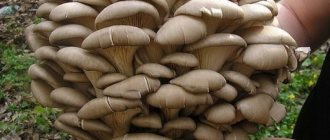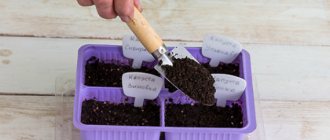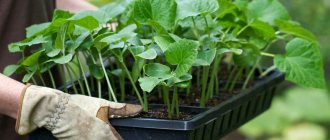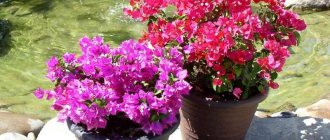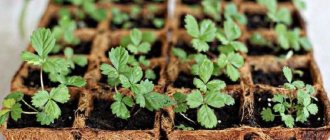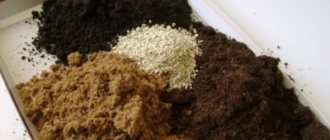Strong, healthy seedlings are the key to a good harvest. The famous agronomist and permaculturologist Nikolai Kurdyumov never tires of reminding gardeners that seedlings are not a future plant, they are already a plant; if at its seedling stage it is sick, frail and lifeless, then it will never become healthy and strong at all. In this article we talk about two diametrically opposed methods of growing seedlings that are popular in 2022. One is reminiscent of Michurin’s “do not expect favors from nature, take them from her,” the second involves minimal intervention in natural processes, but both of them are aimed specifically at obtaining high quality plants.
How to choose quality seeds?
Plenty of seed choices
The quality of grown crops and their yield largely depend on the correct selection of seeds. Unfortunately, in recent years, mismatched varieties have often gone on sale - instead of the indicated varieties, not only other varieties, but even seeds of other crops are packaged. And their germination rate leaves much to be desired.
Good seeds are sold by “Russian Garden” and “Gavrish”. , “Biotechnika”, “Agro, unfortunately, have stopped monitoring quality - many gardeners complain about their products.
Crop yields may vary from year to year. To be on the safe side, it is better to plant 2-3 varieties of each crop.
When purchasing seeds, be sure to pay attention to the area where a particular crop grows. For example, open ground tomato seeds of southern varieties may be unsuitable for growing in Siberian conditions.
What crops are grown on the windowsill in winter?
You can grow almost any seedling on a windowsill. These can be cucumbers, tomatoes, sweet and bitter peppers, beans, carrots, herbs and so on. The main thing is to create suitable conditions.
Preparing petunia seeds. Photo used as illustration. Source: Yandex.Images
You also need to know in what order to sow the seeds. Peppers, eggplants and celery come first. The optimal time for sowing is considered to be the end of February or the beginning of March.
Sowing of cabbage, onions and tomatoes begins in mid-March. It is not advisable to do this earlier: the seedlings will stretch and weaken. In April it is recommended to sow cucumber seeds.
Window sills can be used for growing flowers. These can be either annual or perennial plants. These include: Chabot carnation, primrose, lobelia, ageratum, petunia, godetia and others. Sowing dates depend on the variety.
Note! Vegetables and flowers need to be distinguished.
Is it possible to collect seeds at home?
Well-ripened seeds, collected from your own garden, sprout together. Plus, you will always know exactly what year you prepared them.
There is less hassle with flower seeds. The ripened flowering shoots are dried well and the seeds are removed from them, which are placed in paper bags. Slightly unripe seeds can easily reach indoors. Just don’t forget to sign the name of the variety and the date of collection (after all, the seeds remain viable for only a few years).
Selected seeds
The fruits of tomatoes, peppers, and cucumbers must be selected the largest, smoothest, well-ripened, even slightly overripe. You can leave them to ripen in the window. Then the seeds along with the juice are squeezed into a small container and sent to ferment in a warm place for 2-3 days. If there is not enough liquid, you can add a little water.
Such fermentation is necessary for several reasons:
- during this process, the seeds are disinfected, bacteria and pathogens brought from the garden die;
- a fragile sprout does not always manage to quickly break through the thin film (placenta) covering each seed; during the fermentation process it dissolves;
It is very difficult to separate sticky seeds one seed at a time; after fermenting the pulp (crushed mass of the fruit), this problem disappears. As soon as a thin dark film of mold appears on the surface, the seeds are washed well (it is more convenient to do this with a strainer) and laid out on a small piece of gauze or thin cloth to dry.
When collecting hybrid seeds, there is one peculiarity - it is believed that the ripened fruits of these plants will not have the characteristics of the mother variety. However, you can also harvest quite a decent harvest from them. Sometimes such plants are even superior to the parent variety in some respects.
Seed storage
To ensure that they do not lose their germination, the seeds must be stored in a dry place at room temperature. To avoid mold, it is not recommended to pack them in plastic bags - they must breathe.
In Cold Storage - USDA Gene Pool in Ames, Iowa
The shelf life of seeds varies among different crops. For cucumbers, this period is 3-4 years. In principle, they are stored much longer (sometimes up to 10 years), but after this time the percentage of germination gradually decreases. Cabbage and pepper seeds last a little longer - 3-5 years. Good germination of tomatoes is guaranteed only in the first 3-4 years. For flowers, depending on the species, it can vary from 2-3 to 8 years.
Cucumber seeds are never planted the next year - from fresh seeds you will only get a barren flower. They will be most productive 2-3 years after harvest. But tomatoes, on the contrary, are better to plant in the first year - during this period they give the best germination.
Soil preparation
Plant sprouts in well-fertilized soil will be strong and healthy
The most popular soil for seedlings is a mixture of garden soil, humus and peat (in a 2:1:1 ratio). If the soil is fertile enough, you shouldn’t get too carried away with fertilizers - if necessary, they are applied only after the plants have true leaves. Before picking (transplanting dense young shoots into separate pots), the seeds are planted in one container.
You should not immediately throw seeds into cold soil brought in from the street. To start metabolic processes, it must first be spilled with warm water and then left for several days to ferment. Regardless of whether the soil is purchased in a store or taken from your own garden, it requires disinfection.
Otherwise, the fragile seedlings will quickly begin to be affected by the most dangerous diseases and pests that fall on the seeds from infected fruits. It is unrealistic to fry a large amount of soil efficiently in an apartment due to the strong smell. A small amount of it can be steamed in a water bath.
To obtain high-quality seedlings, fertile soil that is not too heavy is required.
More often, to destroy bacteria, the ground is watered with disinfectant solutions of manganese or biological products: “Fitosporin”, “Fitop”, “Barrier”, etc. To prevent pathogenic bacteria and insect larvae from entering the soil, containers used in previous seasons for seedlings must also be thoroughly washed and treated with any of the above solutions.
It will not be possible to destroy insect larvae in this way. Therefore, the soil brought from the store must be frozen three times. First, they put her out on the balcony for a week, then they bring her into the house for several days, etc. Before planting seeds, the soil must warm up well.
Experienced gardeners prepare their own soil mixture for seedlings of each crop. For example, river sand is added to the soil for planting tomatoes, peppers and eggplants - it makes the soil lighter. In addition to humus and sand, you can add a little lime to cabbage seedlings.
Tea bags
Another interesting and super-economical way to grow fertilizers. You can drink tea first, and then do what you love, using the tea bag again!
Advantages:
- Benefit. No extra financial costs are required: everyone can find tea bags at home.
- Practicality – tea bags gain a second life.
- The tea leaves contain a large amount of substances that are necessary for young plants.
- Convenient diving. The plant can be replanted without damaging the roots or losing the earthen clod.
Flaws:
- If a worn-out bag is used, it can be easily torn.
- Labor intensity. The process requires care and preparation time.
When to plant tomato seedlings?
Tomatoes for growing in greenhouses in the central and northern regions of Russia are grown only by seedlings. Seeds of ground tomatoes can be planted immediately in the ground, without using seedlings. But, if you want to get an early, abundant harvest, it is also better to pre-grow them at home.
The timing of sowing tomatoes may vary in different regions.
- For example, greenhouse tomatoes are planted for seedlings in the Moscow region as early as March 5-10
- Although this time depends on the varieties - some of them have a longer or shorter growing season
- For example, seeds of large-fruited tomatoes, which ripen slowly, are planted at the end of February
- Tomatoes for open ground are sown later, March 20-25
- It’s easy to calculate planting dates in a specific region.
- Seed producers must indicate on each packet the growing season (time from first germination to harvest) of each variety
- For example, for mid-ripening tomatoes it is 90-100 days
If the windows of the apartment are on the shady side, you should not sow any plants for seedlings too early. They will become overstretched, weak and painful. And it will be difficult to transport thin, fragile stems into open ground. It is better to shift the planting date to 1-1.5 weeks later.
How to plant tomato seeds correctly?
Immediately before planting, the seeds are immersed in a solution of salt, soda or manganese for 10-15 minutes and then washed. To speed up germination, if desired, they can be wrapped in a damp cloth, placed on a plate and left for a day.
Planting tomato seeds
After disinfection of the seeds, planting begins. To do this, they are laid out in grooves 1 cm deep at a distance of 3-4 cm or simply scattered over the surface, and then covered with a sufficient layer of earth. To prevent it from drying out, it is better to cover the container with film - after all, the seeds lying in the ground do not need light yet.
Immediately after the entrances appear, it is removed and the container is moved closer to the light. If the seeds were pre-soaked, the sprouts may appear within 2-3 days. When planting dry seeds, the plants will begin to hatch only on day 4-5.
Seedling care
- The optimal temperature for tomato growth is 22°C, at night – 18°C
- When planting seedlings early in February-March, there is still not enough natural light. To prevent plants from becoming overtightened, use lighting
- Watering is carried out as the top layer of soil dries
- At first, little moisture is required, and they are watered after 2-3 days.
- On sunny days the ground dries out a little faster
- As the roots grow and expand, more water is required, and watering should be done more often - every other day, and on hot days, daily.
The first feeding of tomatoes is required only a couple of weeks after the sprouts appear.
In the future, fertilizers are applied little by little, no more than once a week. It is better to use natural ingredients - wood ash or an infusion of dried plants (the ideal option is nettle infusion), stored from the summer.
Picking
After 2-3 true (toothed) leaves appear, they begin picking - transplanting into containers with a volume of about 0.5-0.7 liters. Keep in mind that the plant will have to grow for a couple more months, so planting in smaller pots is not recommended - tomatoes need to grow good roots. Otherwise, the yield will be low.
To prevent water from stagnating at the bottom of the container, be sure to make small holes in it. The window sill will remain clean if you use pallets. A couple of hours before picking, the seedlings need to be thoroughly watered - it will be easier to get them out of the ground without damaging the roots.
For replanting, choose the strongest sprouts with a thick stem and well-developed roots. Stunted and diseased plants are discarded - they will no longer produce a large harvest.
Picking tomatoes
Using a small spatula, carefully remove the sprout from the ground and transfer it to the prepared container. Unlike many other types of plants, it is allowed to bury tomato sprouts right up to the leaves - part of the stem, once in the ground, will immediately give new roots. Make a hole 4-5 cm deep in the ground, water it well and carefully place the sprout there.
Some gardeners lightly pinch the roots for better branching. However, this issue is considered controversial - some, on the contrary, argue that such a procedure only harms natural growth.
To ensure that the roots are evenly distributed to the very bottom, water the plant generously after you have covered it with soil. The roots will be “pulled” closer to the bottom, and excess water will gradually leave through the holes.
Tomatoes tolerate picking perfectly - almost all plants take root. Moreover, it promotes the rapid development of lateral roots. But still, to make the sprouts suffer less, move them to a shaded place away from bright light for a couple of days.
Transferring seedlings to the ground
In the Moscow region, tomatoes are transferred to the greenhouse in late April - May. They are planted in open ground only after the end of return frosts, which often occur in early June.
The land must be prepared in the fall - remove the roots of weeds and fertilize it well. Before planting, holes are prepared at a distance of 60 cm to the depth of a spade bayonet. So that for 1 sq. m can accommodate more plants, you can plant them in a checkerboard pattern.
It is better to put a couple of handfuls of humus at the bottom of each hole (pure manure will simply burn the roots)
If the plants are too stretched out on the window, it doesn’t matter. By using sloping planting, you will only increase your yield. To do this, prepare a long furrow and carefully spread the stem along its entire length, lifting only its upper part above the surface, and then cover it with soil. Try to act carefully so as not to break the plant.
On hot days, it is better to cover the seedlings with burdock leaves or newspapers for several days. This way they will take root much faster.
Black midge (leafhopper) is very dangerous for weak tomato shoots that are only planted in the ground. However, hardened plants suffer from it much less. Before planting, take the seedlings out to the balcony at night more often. The foliage color of well-hardened plants should take on a slight purple tint.
We plant
At home, seedlings are in extreme conditions. For normal development, it needs a large amount of light, as well as a volume of soil. No matter how nutritious the soil mixture in glasses is, plants need more and more of it as they develop.
Look at the photo - during the picking, the seedlings were planted in containers of different sizes. Before planting seedlings in the ground, the difference in plant development is significant.
Pepper seedlings
This crop is more capricious and demanding than tomatoes, and requires special growing conditions. Even in the southern regions, it is never planted directly into the ground - in order to increase fruiting time, pepper is grown only through seedlings.
Pepper seedlings
For greenhouses it is necessary to choose tall varieties. Medium- and low-growing varieties are ideal for growing on beds under film. Early varieties are sown 2 months before transferring to the ground, and late varieties - 70-75 days.
Planting seeds
Pepper is extremely picky about soil quality. Both fresh manure, clean peat, and dense acidic soil are harmful to it. To plant seeds, it is better to use a light mixture of peat, humus, river sand and soil. It is advisable to add a little wood ash.
Planting pepper seedlings
Disinfected seeds of pepper, as well as tomatoes, are planted to a depth of 1 cm. They are planted immediately in a permanent place in pots with a diameter of up to 8 cm. Since the roots of this plant are not too branched, large containers are not required.
Fruits in the shape of cylinders or cones are more suitable for making salads. Moreover, the darker they are, the sweeter they will be. It is better to marinate small peppers. It is most convenient to stuff fruits in the form of “cubes”.
Watering seedlings. Optimal temperature
Watering seedlings
- Despite high drought resistance, pepper seedlings respond well to watering
- This needs to be done infrequently, once every 5 days
- Optimum daytime temperature for growth +22-25°C
- At night 11-14°C is enough
- Just like tomatoes, peppers must be prepared for planting in the ground by hardening
- When the night temperature is +15°C, it is better to place it on the balcony
During strong winds, do not leave the windows open on the balcony - pepper does not tolerate drafts.
Does pepper require picking?
This culture does not tolerate picking very well - the sprouts take root slowly and suffer for a long time. Since at this time the pepper stops growing, the yield may decrease due to the time lost during transplantation.
Watering the pepper
If picking is still necessary, you need to wait for the first two true leaves. You should not delay replanting - the grown shoots will take root worse. Pepper does not tolerate deep penetration of the stem into the ground - they dive it only to the cotyledon leaves.
Landing in the ground
Peppers are planted when the threat of return frosts has passed. In the central part of Russia, seedlings are transferred to the greenhouse at the end of April, under film - until the end of May, and into open ground even later - at the beginning of June.
Pepper does not tolerate frost. If tomatoes can easily survive zero temperatures, then even a prolonged drop to +3°C can be detrimental for peppers. At temperatures below 15°C or sudden changes, it simply stops developing, so in cold weather, do not expect a harvest outside the greenhouse. It does not ripen in partial shade or dense plantings - the plant requires enough sun to develop.
Planting peppers in the ground
For this culture, choose the sunniest place, protected from drafts. When planting in open ground, it is better to raise the beds by 30-50 cm to ensure good heating of the soil. On clay soils, the soil must be dug up with the addition of humus, sand and sawdust.
Sandy soil requires the addition of peat, a little clay soil and humus. When planting in open ground, you must wait until the soil warms up to 15°C. There is no need to rush - in the cold the pepper will stop growing and the yield will decrease.
The optimal distance between plants is 40 cm, between rows 70 cm. For tall peppers, this distance must be increased further. The stem should not be buried in the ground! Try to plant the plant exactly as it grew in the pot.
Many gardeners get too carried away with fertilizers. But few people know that ordinary urea, which actually significantly increases productivity, is a nitrate. Its excess can lead to severe poisoning.
Cucumber seedlings
Growing this crop from seedlings is not so easy. After all, its sprouts are tender and cannot tolerate sudden changes in humidity and temperature. To avoid such changes, even in the house it is better to grow seedlings under a film in which holes are made to allow excess moisture to escape. The root system of cucumbers is also very capricious - it is enough to damage the thin roots, and the plant will not take root well.
Before planting, the seeds need to be sorted. To do this, they are placed in a small container of water. For disinfection, salt, baking soda or potassium permanganate are added to it. Light seeds that float to the surface are discarded. The remaining ones are thoroughly washed with water - salt and soda should not get into the ground.
Cucumber seedlings
The ideal soil for cucumber seedlings is a mixture of peat and sawdust with the addition of a small amount of mullein. It is better to choose a small container, because planting in open ground is done at the age of 25-30 days (plants that are too large will take root worse). In large pots, the soil may turn sour.
The seeds are buried 1.5 cm into the soil. It is better to plant 2 at a time - later the weaker sprout is removed. After planting, the soil is well watered, and the container is covered with glass and placed in a warm place.
Cucumbers are planted in the main place in the greenhouse in mid-May, when the threat of frost has passed. There is no need to thicken the plants - they are planted at a distance of 50 cm in a checkerboard pattern. Too frequent planting due to lack of air circulation is fraught with the development of a dangerous disease - powdery mildew.
Growing cabbage seedlings
The timing of sowing cabbage depends not only on the region, but also on the plant variety. The vegetative period of late-ripening varieties, such as Moskovskaya, Amager, Kolobok, Sugarloaf, is considerable and amounts to 160 days, so they are planted at the end of February. Mid-season varieties ripen in about 100 days. Vegetation of early ripening varieties is up to 80 days.
It is better to plant seedlings of mid-ripening and early-ripening varieties directly outside in a small greenhouse. After all, cabbage does not tolerate the home microclimate – lack of moisture and temperatures above 16-20°C.
When growing late-ripening varieties for pots with seedlings, you need to choose the coolest place in the house. On the window next to the radiators, it will be stunted; you will not get large, tight heads of cabbage from it. If possible, it is better to place the seedlings on a balcony or unheated veranda.
Cabbage seedlings
The seeds are planted in grooves 2 cm deep at a distance of 4-5 cm from each other. If they are located more often, after the first leaves appear, the plants are thinned out. Before the seedlings peck (this happens on days 5-7), the containers with soil are covered with film.
The plants do not dive, but after 3-4 leaves appear, they are transferred to open ground. Cabbage easily tolerates cold temperatures down to -5°C, so it is planted in open ground in May-June, and under film even at the end of April.
When replanting, you should not deeply bury the sprouts below the cotyledon leaves. If you cover the top bud with soil, it simply won’t form a head of cabbage.
Eggplant seedlings
Eggplant seedlings
- This southern plant requires light, moisture-absorbing, well-fertilized soil - a mixture of humus, sawdust, peat (2:0.5:1) with the addition of sand
- Seeds are planted into the soil several at a time in one hole to a depth of 1.5-2 cm at a distance of 2-3 cm
- After the sprouts appear, the strongest ones are left
- Picking is carried out only as a last resort - eggplants do not tolerate it well
- The growing season of eggplants is 130-160 days, so they need to be sown as seedlings in February
- They are transferred to greenhouses in May-June. Even experienced gardeners often shrug
- No matter how they care for the seedlings, they develop very poorly or even stop growing
There may be several reasons:
- lack of minerals: eggplants are very demanding on the soil; Seedlings will develop well only on well-fertilized soil
- Growth cessation is also possible with a lack of light
- excess moisture and, as a result, damage to the root system
- tight container: if you remove the plant from the pot and find that the roots have darkened (the first sign of lack of soil), transplant the seedlings into a larger container.
Pumpkin and zucchini
To obtain an earlier harvest, the seedling method is used. About a month before the onset of warm days, pre-germinated seeds are sown in individual containers with a diameter of about 15 cm, covered with film, room temperature.
As soon as the shoots appear, it is placed in a cool place so that the root system develops. At this time, light and moderate watering with warm water are needed; pumpkins and zucchini grow quickly. The soil for filling the pots is chosen to be rich in humus and loose.
When frosts are no longer expected, warmth has set in, and up to three main leaves have already turned green, the crops are planted in their places, but undergo a hardening procedure within 10 days.
Strawberry seedlings
This berry can be planted as seedlings from seeds collected with your own hands or purchased in a store. To get strong shoots, this must be done in February. To do this, prepare loose soil from a mixture of humus, wood ash and garden soil (proportions 3:0.5:3).
You can simply mix humus with sand 5:3. Disinfected seeds are laid out with a toothpick at intervals of 3-4 cm and, without covering them with soil (they germinate only in the light), immediately cover the container with film.
The root system of strawberries must be well developed before planting.
You can also use peat pots - in this case, picking is no longer required. You will have to wait a long time for entrances - 2-3 weeks. Plants are gradually accustomed to lower temperatures by briefly removing the film (first for an hour, then two, etc.), only after the appearance of real leaves.
Plants dive when 3-4 serrated (true) leaves appear. If the strawberries are developing at a rapid pace, transplanting into larger containers can be repeated. It is transferred to a permanent place in the ground when the soil temperature reaches 12°C in May-June.
conclusions
Whatever method of growing seedlings we choose, the main thing is to get healthy and strong plants before planting in the exhaust zone. Here are the signs of good seedlings:
- the bushes are not deformed, there are no spots or plaque on the leaves;
- the bushes are not damaged by pests;
- leaves are colored evenly;
- the bushes are stocky, strong, not “legged”;
- the root system is well developed, it is branched, it grips the earth well, the tips of the roots are white;
- The internodes of the stem are compact, and the stem itself is strong.
Read on FORUMHOUSE how to calculate the timing of planting seedlings in 2022, how to make a budget lamp for seedlings using LEDs with your own hands, and how to make racks for seedlings. Read how to grow strong seedlings and how to prepare the perfect homemade soil. You can also discuss any relevant questions with us and get advice on seedlings.
Petunia seedlings
To obtain abundantly flowering plants, you should start planting these flowers in February-March (planting dates depend on the specific region). The soil for them should be sufficiently nutritious and loose - you can use either special soil, which is sold in the store, or a mixture of earth, humus, sand and peat.
Petunia seedlings
Small petunia seeds are not covered with soil - heavy soil will not allow them to sprout. Therefore, snow is used when planting. It is scattered over the surface, and the seeds are carefully placed on top with a toothpick. When the snow melts, it will “pull” them into the ground.
To prevent the soil from drying out and the seed shell to become wet and dissolve well, the container is immediately covered with plastic wrap. You shouldn’t remove it suddenly in one day. After the real leaves appear, the film is removed daily, first for half an hour, then an hour, etc. Petunia is transferred to open ground after warm weather sets in. In central Russia, this time falls in May - early June.
Citrus peel
Fragrant orange fruits contain essential oils. The smell that is pleasant to us is not at all pleasant to underground pests.
Advantages:
- Useful microelements contained in orange zest nourish the soil.
- The smell repels pests.
- Orange peel does not pollute the soil; over time, it decomposes, further improving the soil structure.
- It is not difficult to prepare skins suitable for seedlings.
Flaws:
- The crusts must be protected from drying out. You can store them in the freezer.
Lamps for illuminating seedlings
When planting late-ripening plant varieties in February-March, when there is still not enough sun, or when growing seedlings on windows facing the shady side, mandatory lighting is required. Otherwise, the plants will become overstretched and stunted, which will affect their future yield.
LED phytolamp
Ordinary incandescent lamps are not suitable - for these purposes you need to acquire fluorescent ones. At a distance from the light source of about 1 m, about 150 watts are required per square meter. For illumination, you can also purchase a special phytolamp with blue and red light waves, the most important for plant growth.
